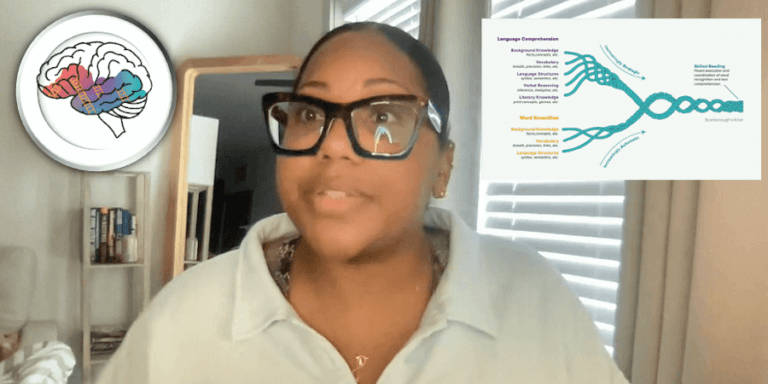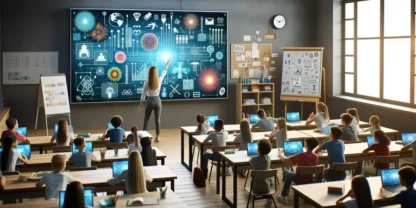I should know this already, I thought to myself, not for the first time. I was in the midst of a deep dive into the rabbit hole that is the science of reading for teachers, and it felt like one epiphany after another.
I was fascinated and frustrated in equal parts; fascinated by what I was learning about early reading instruction, and frustrated that I hadn’t been equipped with this knowledge before I was tasked with teaching students how to read. The science has been there for decades—why wasn’t this a stronger point of emphasis for every new teacher?
Watch the Video
In the Classroom
I was three years into my teaching career at that point, serving as a Literacy Coordinator and Early Interventionist at a charter school in the Metro Atlanta area. The science of reading hadn’t really been on my radar, at least not by that name. I knew many of the underlying concepts, but it had never been presented to me in a formal, unified way.
Some of this was bad luck—I focused on middle grades education in college, and foundational skills were not the priority they might have been for my elementary counterparts. That said, I was coming off three years as a pre-K and elementary teacher, and some of the strategies I was now learning about on my own had never even come up during that time. The public elementary school I was at the year before didn’t even have an early reading curriculum in place, let alone one aligned to all the research I now knew existed.
This was around the same time that Hard Words—the APM report by Emily Hanford that helped bring the reading wars back into mainstream consciousness—was released. Schools and districts were reexamining their approaches to early reading and many, including the school I had just left, scrambled to adopt new phonics curricula or at least set clearer expectations around how reading should be taught. As a result, many new teachers now have more support and resources for reading instruction, but too many gaps still persist.
Ultimately, I used my newfound knowledge of the science of reading to develop a year’s worth of small group literacy lessons and to help my new school in the difficult transition to virtual literacy instruction in the midst of the pandemic. I’m proud of what we accomplished, and even though I’ve since left the classroom, that time will always be an important part of who I am.
In Learning Design
The science of reading has become a bit of a guidestone for me in my current role as a learning designer at eSpark, and it’s something I intend to spend even more time absorbing as I continue on this journey.
The goal remains the same: to help students develop the skills they need to become confident readers. The way we need to do it, though, is totally different. I know we only have students for short bursts, whether that’s happening in half an hour of center time here or 20 minutes of free choice there.
These are just some of the things our team is thinking about when creating new learning experiences:
1. Systematic & explicit instruction
The systematic part of this is tricky, especially with an adaptive program like eSpark. We have to not only unpack each standard into required subskills and deliver those in an appropriate sequence, but also make sure each Quest is building on previously acquired knowledge so students have the requisite skills they need before being introduced to a new concept. Then, we give the students multiple opportunities to master a standard before moving them to the next step in the sequence.
We take care of the explicit half of this duo by starting each Quest with what we call a “Framing Video.” We use this video to clearly and concisely tell students what they will learn and why it matters before introducing the concept through both direct modeling and guided practice. Students have enough going on without having to deal with ambiguous learning objectives.
2. The five essential components of reading instruction
This is one of the biggest differences from the classroom to an online environment. It’s really easy for me to summarize how I can weave all five components of reading (phonemic awareness, phonics, fluency, vocabulary, and comprehension) into a lesson as a teacher, but it gets a little more nuanced from a learning design perspective because the time students spend with our program is so limited.
We make a point to expose students to multiple components in any given Quest. We don’t try to force it into each and every lesson, but our goal is for every student’s learning path to touch on all of these components over time. We also create critical-thinking questions specifically to challenge vocabulary, which is not explicitly covered by state standards in the same way as the other components.
3. The simple view of reading
One of my biggest takeaways from my experience with the science of reading is how consistently the simple view of reading has been validated. This is the idea that reading comprehension is a product of language comprehension and word recognition. We try to focus on this as much as possible in K-2 so we can set developing readers up for success.
As the ELL population continues to grow, we know we’ll have to pay close attention to the comprehension half of this model. Much of this is already covered by existing state standards for Language, but it is always our goal to make our curriculum as accessible as possible and remove any barriers to entry we identify along the way.
Sparking a Love of Reading
We use a really unique play-to-learn approach here at eSpark, where we weave activities and games into the learning process. That goes a long way toward keeping students’ attention, but the concept of “engagement” is more nuanced than just “making learning fun.”
We also need to make sure students can see themselves in the learning materials. That means diverse representation throughout the curriculum—are we using examples of different ethnicities, cultures, and ableness? It also means double- and triple-checking content for age-appropriateness. The last thing we want to do is put something in front of a student that’s either over their head or feels too juvenile for their stage of social and emotional development. It’s a fine line to walk, especially when you’re creating content that will be used by millions of students from different backgrounds throughout the country, but we are always looking at this and identifying areas where we can improve.
The research is very clear on the fact that students who read more and students who read for pleasure enjoy better outcomes by almost any measure of academic success, yet the percentage of students who report doing so is at its lowest mark in 40 years, and the number is continuing to fall (Pew Research). It is my hope that the entire education community can rally around the science of reading, and that our teachers, administrators, and school of education professors can all finally get on the same page about what works before we pass the point of no return.
Make no mistake; this is a generational crisis, and it’s only been made worse by the pandemic. Disparities across racial and ethnic lines are stark and growing. It’s on all of us to continue to find new ways to spark a love of reading in the next generation. Too much is at stake for this not to be a priority.
——————-
DaNadia Johnson is a career educator with experience in traditional public, private, and charter school settings. She holds a Bachelor of Arts in Interdisciplinary Studies (Education and Psychology) from the University of South Carolina Upstate and is pursuing a Master of Science in Instructional Design and Technology from Georgia State University. DaNadia is an avid reader and was a mission-driven learning designer with eSpark at the time this article was published.



